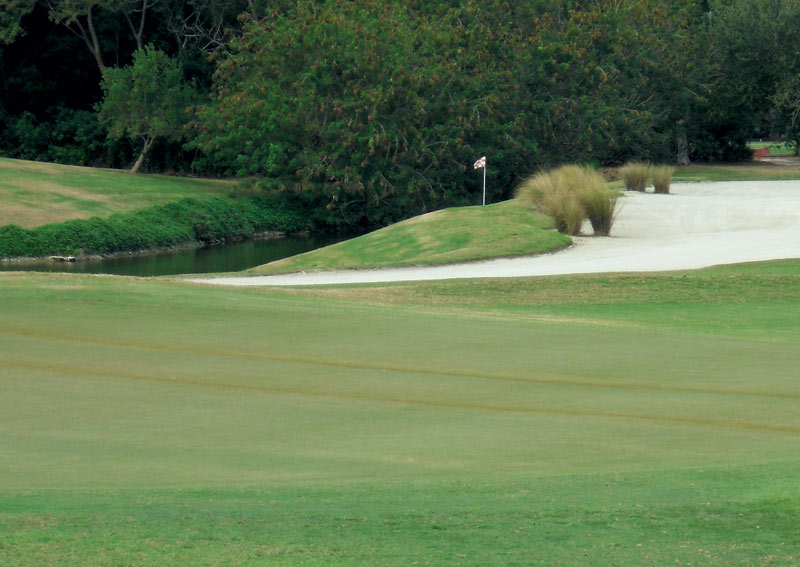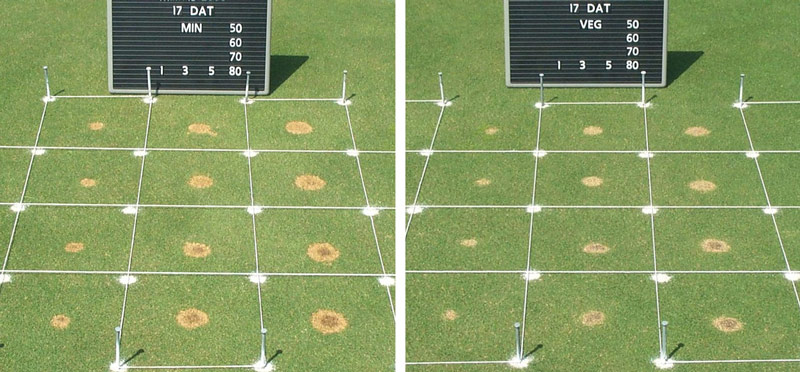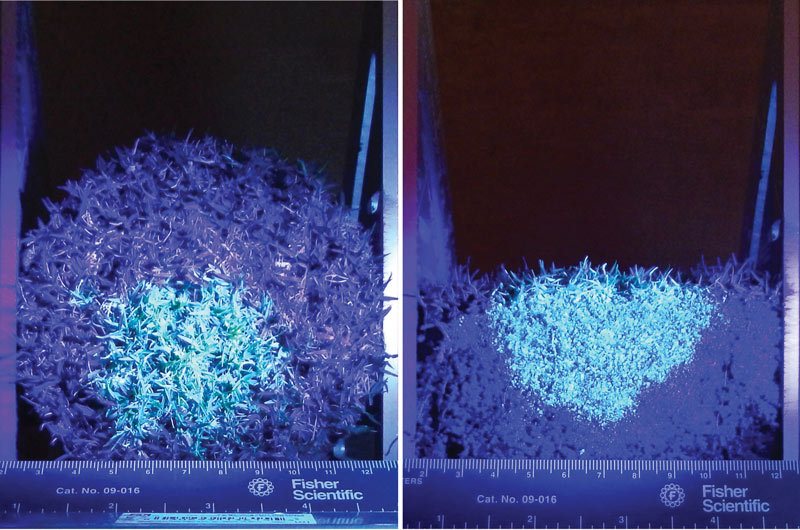
Oil spills from the equipment used to carry out standard golf course maintenance practices can cause serious damage to the playing surface that may require turf replacement. Photos by William L. Berndt
Hydraulic systems are common on turfgrass management equipment, but if hydraulic oil leaks onto turfgrass from maintenance equipment, the result can be injury or loss, especially on putting greens.
Recent posts on social media have commented on the nature of hydraulic oil injury and what to do about it. Comments about oil spills that are quoted in this article were originally posted on the closed Facebook group Golf Course Maintenance, which has approximately 13,900 members. The goal of this article is to help separate fact from fiction regarding spills of hydraulic oil on putting greens based on replicated research conducted over the past 15 years.
What kills the grass?
Many sympathetic comments get posted in response to posts and photos about hydraulic spills, but opinions differ about the nature of the turfgrass injury and what to do about it. A recurring theme in the responses to reports of hydraulic oil injury is that the temperature of the oil, not the oil itself, is what causes turfgrass injury, as seen in the following posts:
“The grass will turn brown from oil temp.”
“Hydraulic oil temp is what kills.”
“The oil doesn’t hurt the turf; it’s the heat in the oil.”
“I don’t think anybody is disagreeing that the heat from the oil killed the grass.”
“It’s the heat not the oil.”
As these posts indicate, probably the most glaring myth that persists is that the heat associated with hydraulic oil spilled from a machine at operating temperature is solely responsible for the turfgrass injury.

Figure 1. The effect of oil temperature on Tifdwarf hybrid bermudagrass shoots in March 2006. Both petroleum oil and vegetable oil were toxic at all temperature/volume combinations. All injury persisted more than 30 days after treatment.
Research examining the effect of temperature associated with spills of hydraulic oil was conducted in Fort Myers, Fla., in 2005 and 2006 and reported in GCM (2) and Applied Turfgrass Science (3). When either petroleum hydraulic oil or vegetable hydraulic oil was heated to four different temperatures (122 F, 140 F, 158 F and 176 F [50 C, 60 C, 70 C and 80 C]) and then applied to a Tifdwarf hybrid bermudagrass [Cynodon dactylon (L.) Pers. var. dactylon × Cynodon transvaalensis Burtt-Davy] green in 2005 and 2006, the results indicated that the temperature of the oil at the time of treatment did not make a difference in percent shoot necrosis (Figure 1, above). Spills of both oils at all experimental temperatures resulted in 100% shoot necrosis that lingered for more than 30 days after treatment.
Follow-up research conducted in Fort Myers, Fla., in September 2014 and reported in 2014 (4) and 2018 (5, 6) sought to verify the experimental findings from 2005-2006 (Figure 2). When 0.10 fluid ounce (3 milliliters) of petroleum hydraulic oil was applied to a TifEagle hybrid bermudagrass green, at either the ambient outdoor temperature of 95 F (35 C) or after the oil had been heated to 176 F, there was no difference in percent necrosis of turfgrass shoots seven days after treatment. Both treatments resulted in 100% shoot necrosis, indicating that hydraulic oil at ambient temperature killed turfgrass shoots just as hot oil did. Hydraulic oil does not need to be hot to kill turfgrass; it is toxic.
The reality of heat-induced turfgrass injury can be observed in Figure 3. Where 0.10 fluid ounce of petroleum hydraulic oil heated to 176 F made initial contact with TifEagle shoots, the oil burned the shoots, causing 100% shoot necrosis within 24 hours. Treatment with hot oil reduced time to 100% necrosis at the point of contact. This might be commonly observed in the field when spills occur from machines at operating temperature.
However, from Figure 3, it was also apparent that, after initial contact had been made, the oil spread laterally in all directions from the point of contact over 24 hours. This observation was verified by replicated research (7). Where the oil spread, the turfgrass plants acquired an oil-soaked appearance within 24 hours of contact, and the shoots died within seven days, providing evidence that hydraulic oil is toxic to turfgrass at ambient temperature (95 F).
The mechanism of toxicity has not yet been fully determined, however. Hot oil killed turfgrass shoots, but after the oil had cooled to ambient temperature and spread laterally over or through the underlying thatch, mat and soil, it also killed TifEagle shoots. The same results occurred when vegetable hydraulic oil was applied.
It is notable here that when water was heated to either 158 F or 176 F and applied to TifEagle, it also killed the shoots. Necrosis was 100% at the point of contact, but expansion of shoot necrosis after the spill event was not observed, and turfgrass injury was limited to the point of contact. Any hot fluid can kill turfgrass shoots, because fluids can carry heat, but hydraulic oils, both petroleum-based and vegetable-based, are toxic to turfgrass independent of temperature.
Treating turf injury from an oil spill
In turfgrass management folklore, dishwashing liquid is a popular cure-all for problems ranging from algae to oil spills. The following suggestions from the Golf Course Maintenance Facebook group regarding oil spills should therefore come as no surprise.
“Dawn soap.”
“Been there. Dawn soap.”
“Fertilizer and water the hell out of it.”
“Tide detergent and a hand waterer.”
“EnBio hydraulic oil does not kill turf. You can soak it through.”
“Simple Green and wash in.”
No one method is universally accepted for mitigating the effects of a hydraulic oil spill, simply because no single method for mitigating the effects of a spill is appropriate for all situations. The success or failure of each mitigation method reported by superintendents is mostly anecdotal, and replicated research has thus far failed to elicit a suitable method for remediating hydraulic oil spills.
Water
Washing hydraulic oil spills with water enhanced mitigation of spills of synthetic hydraulic fluid, but it did nothing to mitigate injury associated with spills of either petroleum or vegetable hydraulic oils (7). Oil is less dense than water, meaning oil floats on water. Thus, washing a hydraulic oil spill with water may increase the injury area and the potential for environmental pollution by floating it over a larger area.
Detergent
Using water plus detergent has been investigated (6), but results indicated that applying liquid detergent immediately after a spill of vegetable hydraulic oil heated to 176 F and then washing the area for 10 minutes with water made the injury worse. The theory is that the detergent disperses the oil so that it can be washed away. However, movement of dispersed oil with intensive washing probably just sends it deeper into the soil profile, where the oil becomes a pollutant, or the washing floats the oil farther away from the point of contact, impacting a larger area of turf.
Vegetable-based and synthetic oils
Using biodegradable, vegetable-based oils has been recommended to mitigate the long-term negative effects of petroleum hydraulic oil (8), but more recent research has shown that vegetable oil is just as toxic to turfgrass plants as petroleum hydraulic oil is (2, 3, 4, 6, 7).
Synthetic hydraulic fluids may reduce the extent of turfgrass injury associated with spills, but when a polyalkylene-glycol-based hydraulic fluid was heated to 176 F and spilled onto a TifEagle hybrid bermudagrass green, it injured the shoots severely (7). The extent of the injury was significantly less compared with injury caused by vegetable/petroleum oils, and the injury healed significantly faster, but noticeable, long-lasting turfgrass injury occurred (7). The injury area for a 0.10-fluid-ounce spill of synthetic hydraulic fluid heated to 176 F was nearly 3 square inches (19.35 square centimeters) at 17 days after the spill occurred, and decreased to about 1.9 square inches (12.25 square centimeters) at 38 days afterward. Turfgrass injury was still visible 45 days after the spill.
It should be noted that one participant on social media posted a testimonial that the same synthetic fluid was not toxic to turfgrass in other research, but no reference to the research was provided.
More (pragmatic) responses
Other responses on what to do about hydraulic oil spills may be more pragmatic, at least in terms of the environment. For example:
“Cut sod from a practice or nursery green.”
“It is dead and won’t come back as long as the oil resides in the profile.”
“Cut the sod out ASAP, as the oil is migrating as we speak.”
Depending on the size of the spill, replacing the turf may be a better idea than trying to wash it with detergent or flush it with water.
Oil spills and the soil
Recent research has demonstrated that spilled hydraulic oil infiltrates soil. When 0.10 fluid ounce of petroleum hydraulic oil amended with ultraviolet (UV) dye was spilled onto the center of cup-cutter-size plugs (4.25 inches [10.8 centimeters] in diameter) of TifEagle hybrid bermudagrass, the oil infiltrated the soil, making contact with underground plant parts (Figure 4, below).

Figure 4. These images were taken 24 hours after TifEagle hybrid bermudagrass was treated with a 0.10-fluid-ounce spill of ambient-temperature petroleum hydraulic oil amended with ultraviolet (UV) fluorescent dye. Images were taken under UV light at a wavelength of 395 nanometers. Wherever it migrated, the oil fluoresced under UV light. The images show the distribution of the spill on the surface shoots (left) and in the soil profile underlying the surface spill (right). Both shoots and underground plant parts were affected by the spill. Scale is shown in centimeters.
Slicing the oil-treated plugs in half and shining UV light on the slices revealed spilled oil had formed a three-dimensional oil spill plume. The plume was likely formed by the force of gravity and the forces of capillarity associated with the soil matrix. Spilled hydraulic oil migrated laterally from the point of contact, forming a surface injury area that was roughly 3 inches (7.6 centimeters) in diameter and about 7 square inches (45 square centimeters) in area. It also migrated vertically into soil to a depth of more than 1.5 inches (3.8 centimeters). The three-dimensional volume of the parabola-shaped plume in Figure 4 was estimated to be about 6 cubic inches (98 cubic centimeters). Large spills with large volumes of hydraulic oil equate to high levels of oil pollution in the soil, not just on it.
Conclusions
The research cited here illustrates several important findings. First, it verifies that spills of hydraulic oil coat turfgrass shoots and infiltrate putting green soil, affecting roots and soil organisms as well as shoots. Second, it verifies that a relatively large plume developed from a relatively small spill because of gravity and capillarity. Because the spill volume was only 0.10 fluid ounce (3 cubic centimeters or 3 milliliters) and the volume of the plume was estimated at about 6 cubic inches, the oil had spread through the soil from the initial point of contact, expanding the effective contact point between spilled oil and the turfgrass system by more than 750%. Everything within the effective point of contact was fouled by oil.
Oil spills as environmental pollution
The research also suggests that spills of petroleum hydraulic oil are environmental pollution events. Petroleum-based oils, and especially used oils, contain many hydrocarbon constituents, including polycyclic aromatic hydrocarbons (PAHs), which can become environmental contaminants that may migrate away from the point source with water.
Used petroleum oil was reported to contain up to 20 ppm of benzene (11), a known carcinogen linked to leukemia. Petroleum-based oils associated with the manufacture of petroleum hydraulic oils are reported to contain many differing hydrocarbons, typically having carbon numbers in the range of C20 to C40 (1). A study of soil in Canada in 2002 indicated that soil contaminated with hydraulic oil contained trace amounts of benzene along with readily detectable amounts of other PAHs, including naphthalene (12). Naphthalene is a Group 2 carcinogen according to the International Agency for Research on Cancer, meaning it is possibly carcinogenic. Both benzene and naphthalene are soluble in water, which means that, with each rainfall or irrigation event, these hydrocarbons could (at least in theory) leach from a petroleum hydraulic oil spill, especially one with an expanded point of contact.
The potential for hydrocarbon leaching could be enhanced in artificially drained, modified-sand soils with low organic carbon content, such as putting green root zones. Most PAH compounds are insoluble in water but may be volatile, leading to migration (movement) into the atmosphere. The larger the oil spill, the greater the potential for hydrocarbon migration and subsequent environmental pollution. Therefore, flushing the oil into soil by washing or leaving the oil alone and doing nothing about it could lead to significant environmental pollution events, impacting both water and air. Removing the contaminated soil in the event of a large spill appears both reasonable and prudent.
Mitigating and preventing oil spills
Materials, products and methods used to mitigate turf injury from spills of hydraulic oils have been promoted in the popular literature for many years and are now being promoted on social media. For example:
“Water, water and more water ASAP.”
“Topdress.”
“Scalp the area as low as possible to remove as much oil as possible.”
“Use a wetting agent pellet with a hose.”
“Large core aeration, and a lot of patience.”
“Charcoal.”
“ASAP apply kitty litter and wet down.”
“Go electric.”
The suggested materials and products include adjuvants and surfactants, calcined clays, organic penetrants, granular absorbents and bacteria, absorbent fibers, emulsifiers and saponifiers, and activated charcoal. Specific turf repair tactics have been offered (9), and, in fact, a U.S. patent for a method of removing oil from a golf course has been granted (10).
Hydraulic oil spills can be prevented by using electric equipment. Removing the potential for spills by using equipment that does not operate on hydraulics is likely the best solution, but this solution is not yet practical, as cost considerations force golf courses worldwide to rely on conventional machinery driven by hydraulics.
None of the espoused materials or methods for repair appears to work that well. They may work to some degree in individual cases, but if one method of mitigation worked, it would be used extensively.
The turfgrass industry is still searching for truly effective tactics to mitigate hydraulic oil spills on putting greens.
The research says ...
- Petroleum and vegetable hydraulic oils and synthetic hydraulic fluids, whether heated or at ambient temperature, have all been found to severely damage and kill turfgrass.
- Injury from synthetic hydraulic fluids may be smaller and heal faster.
- Spills of hydraulic oil coat turfgrass shoots and infiltrate putting green soil, fouling roots and soil organisms as well as shoots.
- A relatively large oil plume can develop from a relatively small spill of oil because of gravity and capillarity.
- Oil spills are environmental hazards that require appropriate mitigation and prevention.
Literature cited
- Anderson, J.E., B.R. Kim, S.A. Mueller and T.V. Lofton. 2003. Composition and analysis of mineral oils and other organic compounds in metalworking and hydraulic fluids. Critical Reviews in Environmental Science and Technology 33(1):73-109.
- Berndt, William L. 2006. Effect of hydraulic fluids on warm-season putting greens. Golf Course Management 74(9):97-100.
- Berndt, W. L. 2007. Effect of synthetic hydraulic fluid on warm-season turfgrass. Online. Applied Turfgrass Science (http://dx.doi.org/10.1094/ATS-2007-1119-01-RS) Accessed Sept. 29, 2017.
- Berndt, William L. 2014. Hydraulic oil spills on hybrid bermudagrass greens. Golfdom (www.golfdom.com/hydraulic-oil-spills-on-hybrid-bermudagrass-greens) Accessed Oct. 1, 2019.
- Berndt, L. 2018. Does temperature influence hydraulic oil injury? Golfdom 74(1):47.
- Berndt, L. 2018. Hydrocarbon machine fluid injury on greens: What do we know? Golfdom 74(3):36-39. (www.golfdom.com/hydrocarbon-machine-fluid-injury-on-greens-what-do-we-know) Accessed Oct. 1, 2019.
- Berndt, W.L., J.W. Riger and C.W. Riger. 2017. Nonlinear regression modeling of hydraulic oil injury on a bermudagrass green. International Turfgrass Research Society Journal doi:10.2134/itsrj2016.04.0216
- Elliott, M.L., and M. Prevatte. 1995. Comparison of damage to ‘Tifgreen’ bermudagrass by petroleum and vegetable oil hydraulic fluids. HortTechnology 5:50-51.
- Gilhuly, L. 2009. Hydrauleak — a method to speed recovery. USGA Green Section Record (www.usga.org/course-care/hydrauleak--a-method-to-speed-recovery-54091.html) Accessed Sept. 30, 2019.
- Nelson, J.H. 1989. Method of removing oil from a golf course. United States patent # 4,817,647. United States Patent Office, Washington, D.C. (www.uspto.gov) Accessed Sept. 30, 2019.
- Todd, G.D., R.L. Chessin and J. Colman. 1999. Toxicological profile for total petroleum hydrocarbons (TPH). U.S. Department of Public Health and Human Services, Agency for Toxic Substances and Disease Registry, Atlanta.
- Wang, Z., M. Fingas and L. Sigouin. 2002. Using multiple criteria for fingerprinting unknown oil samples having very similar chemical composition. Environmental Forensics 3:251-262.
William L. Berndt was a faculty member at Edison State College and Florida Gulf Coast University, and is currently the president and senior consulting agronomist of William Berndt Associates in Fort Myers, Fla.